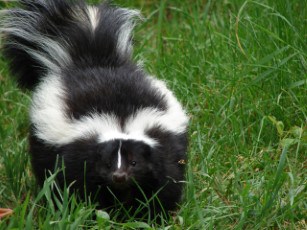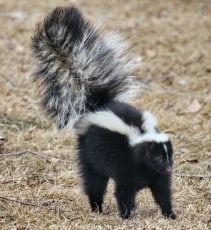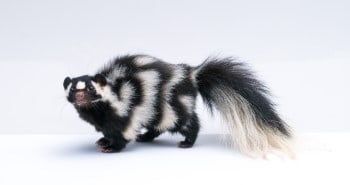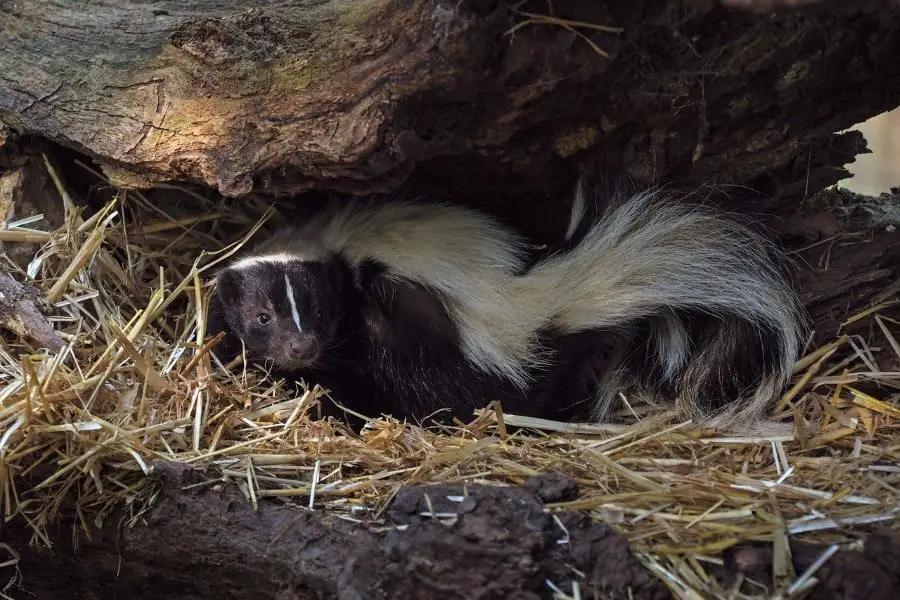Ever wondered where Skunks actually live? Either which areas they populate in the world, or what kind of habitat suits them best? Perhaps you need to identify a skunk by its geographical area and habitat?
Well, here we’re going to answer all the questions surrounding where Skunks live in the world, where skunks live in terms of their habitat, and which skunks prefer which type of habitat.
First, here’s the quick answer, then we’ll dive into more details…
Where do skunks live? Skunks are largely native to both North and South America, including the Bahamas. But species can be found as far and wide as Indonesia. Locally Skunks thrive in a number of environments, woodlands, deserts, grasslands, mountain areas, and even urban fringes
There’s a lot more to explore here, so now we’ve seen the quick answer, let’s dive into more detail so you can perhaps identify your particular type of skunk by its area and habitat. Starting with where Skunks are found in the world.
Where skunks live in the world
Skunk’s can be found throughout Canada and North and South America. The species of skunk will determine whereabouts they’re found throughout each of the countries and other continents.
When we think of a skunk our minds conjure up an image of a creature with black fur that has a white ‘v’ shape running down its back, and white between the eyes. This is a striped skunk, and they can be found in a variety of locations throughout central and southern Canada, as well as North and South America.
- Hog-nosed skunks – skunks with longer snouts, cover a much broader range. Also known as striped skunks, they’re located within Southern Canada and throughout the USA, as well as the Caribbean and plenty of locations in South America.
- Molina’s hog-nosed skunk – resides in Southern Brazil, Chile, Peru, and Northern Argentina.
- Humboldt hog-nosed skunk – also known as the Patagonian hog-nosed skunk frequents the Patagonian region.
- Spotted skunks – who are technically not spotted but covered in a series of stripes along their back and the sides are the smallest of the skunk family. Ranging from South West Canada all the way to Costa Rica.
- Hooded Skunk – The hooded location ranges from the Southwestern United States through to Mexico where it is a smaller size and in greater numbers. Down to Guatemala, Honduras, Nicaragua, and as far as northwest Costa Rica.
- Stink badger – similar in appearance to the hog-nosed skunks is native to the Philippines, Malaysia, and Indonesia
However, the stink badger is a recent addition to the Mephitidae family. the stink badger became a classified member of the skunk family in the 1990s.

humboldt skunk 
striped skunk 
spotted skunk
What habitats do skunks live in?
With their adaptable nature, the skunk family can live within a wide range of habitats. They thrive in…
- Woodlands
- Deserts
- Grasslands
- Mountain areas
- Urban fringes
As long as they have access to food and water resources; skunks rarely travel more than 1-2 miles from their dens. Here’s a list of everything a skunk eats.
Striped skunks certainly cover a varying range of habitats, being found in agricultural landscapes, grasslands and are happy to live near humans.
Due to their opportunistic eating tendencies, they can cause havoc on campsites or built-up areas as they root through rubbish for a tasty treat – and, of course, no one really wants to go near them!
Spotted skunks favor areas with trees and woods, but again, like the striped skunks are happy to live alongside urban locations. Eastern spotted skunks have a preference for rocky, wooded habitats that offer plenty of vegetation. Whereas the western spotted skunks favor more lowland areas.
The hog-nosed skunks will often choose to make their home alongside water sources, where there’s plenty of vegetation and an abundant food supply.
Why skunks live in these habitats
They choose to live within these habitats because these are the type of environments that allow them to thrive, whether that’s due to their adaptations or because of feeding and foraging opportunities on offer.
Skunks are omnivorous in nature, so they feed on a wide range of foods and aren’t overly fussy. They will eat berries, nuts, insects, rodents, birds, eggs, grains, and rubbish – just to name a few. All of which can be found in many geographical regions and local habitats.
The habitats skunks live in have an abundance of different types of these foods on offer. Also, what’s an easier meal than discarded rubbish from humans – making campsites and the edges of towns a choice location to set up home.
Hog-nosed skunks are more insectivorous than other skunks, because of their long snout, which is perfectly adapted for eating insects. So they inhabit more rural, wooded locations near water that offer them easy access to this type of food source.
The spotted skunks prefer woodland settings, perhaps because of their adaptations for tree climbing. Due to their small size and agile nature, they spend plenty of time off the ground in trees, either foraging for food or hiding from predators.
All skunks will choose habitats with vegetation, scrub and cover that provides a safe location for den building away from predators such as; owls, eagles, coyotes, dogs, and crows.
What kind of dens skunks live in
Typically, skunks will live in dug-out dens with numerous chambers and entrances. Their young are raised in the dens, and multiple chambers allow for more space, as well as offer protection from predators – the different entrance options also assist in allowing escape routes and access to other areas.
As crepuscular animals, skunks will also lay up in their dens during the day where they’re protected, not only from predators but also from the weather. Here’s some more information on whether skunks hibernate. And a list of animals that hibernate.
These dens are often located under rock piles, in dead logs, or even under sheds and outhouses.

How skunks build their den
If they can then skunks will take over the abandoned den of another animal, if not, then they’ll use their sharp and strong front claws to dig away the earth and soil.
The entrance hole is deep and usually around 8 inches in diameter. Fresh piles of earth outside one of these holes, as well as the skunk’s infamous odor, could be a giveaway that one of the Mephitidae family is in residence.
So match that against your geographical location and you may be able to decipher which skunk is in your area.
Learning resources
Continue your learning at home and at school with the ideal resources from Amazon. Help support our efforts for wildlife causes and keep this site working for nature.
Beautiful photos are paired with STEM-appropriate text to offer a basic exploration of the appearance, behavior, and habitat of skunks, the musk-spraying mammals. Also included is a story from folklore explaining the unpleasant scent of skunks.
Discover the secret behaviors of a notoriously stinky mammal–the skunk–by following a family as the kits grow from infancy to adulthood.
Video resources
To Finish…
We hope this has been useful in understanding where skunks live, both in the world and perhaps locally to you.
This content has been checked and verified by a qualified veterinary practitioner. The article has been reviewed by our editorial board and has been approved for publication in accordance with our editorial policy.
